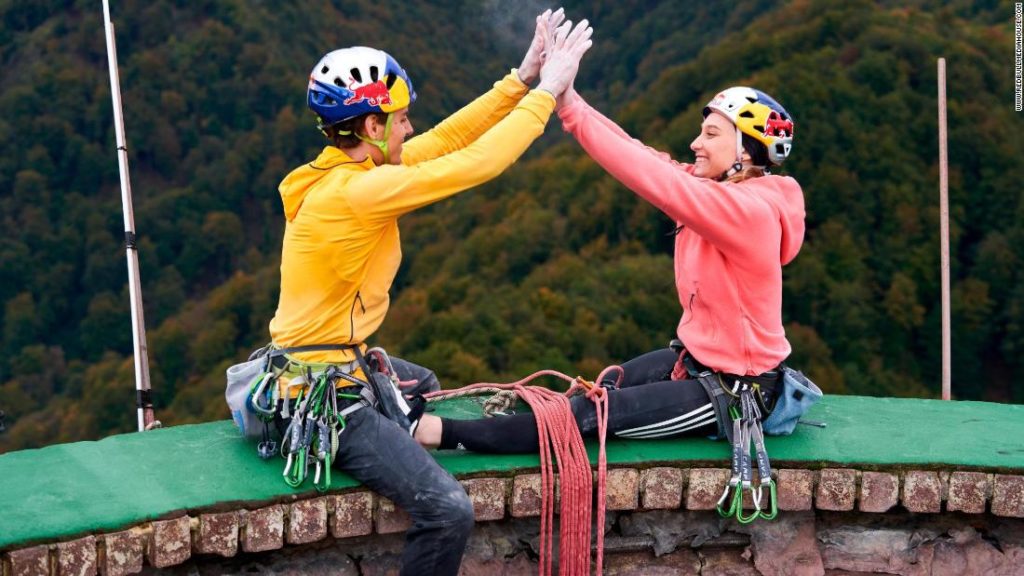In October 2020, Janja Garnbret and Domen Škofic became the first people to free climb the chimney’s new route which is now the tallest artificial multi-pitch route in the world.
The pair, who had just a rope to catch them if they fell, were successful on their second attempt after over seven hours of climbing.
Both climbers are world-class in their own right.
Škofic, 26, was a climbing prodigy and won the Lead Climbing World Cup title in 2016; Garnbret is quite simply one of the most talented sport climbers on the planet.
The 21-year-old has won multiple world championships and World Cup titles and is one of the favorites to win gold when climbing eventually makes its debut at the Tokyo Olympics.
Despite their expertize, the challenge was still way out of their comfort zone, with both more accustomed to indoor climbing where the wall is usually no more than 30 meters high.
This route, however, contained 13 pitches (or sections) and involved rope techniques that are very different from what they are normally used to.
The chimney itself was built in 1976 and used to emit emissions out of the valley where it’s situated. It’s been nonoperational since 2014.
‘Not in my comfort zone’
But the new route, specifically designed over the course of five years, provided a real endurance test for the two climbers.
“It really helps because I’m a person who is always looking for a challenge, who always wants to do something new, to do something better.
“So this is definitely a cool project and it was not in my comfort zone. I had to step out and just enjoy the whole process.”
Their first attempt took nearly 12 hours and both climbers fell on a number of pitches. Carrying heavy backpacks left them physically exhausted and they realized they hadn’t brought sufficient food and drinks to sustain them.
Undeterred, the pair regrouped and went again four days later, successfully scaling the chimney in seven hours and 32 minutes.
Reaching the top after such a grueling climb is a feeling that neither will forget in a hurry.
“When I think back now, I remember how uncomfortable it felt, how it was hot, it was cold, it was windy, it was everything,” Garnbret added.
“I also said one time that I never want to go again, that this was my last try and I never want to go again. But it was a super amazing experience and yeah, I was really happy when I came on the top.”
‘I was more scared looking up’
Although heights come with the territory for climbers, neither had ever experienced such a vertical before.
Škofic still remembers the stomach-churning feeling of standing at the foot of the chimney, looking up as the top disappeared into the clouds.
“I was more scared looking up, watching the chimney. I mean, I had huge respect,” he said.
“But when I was on the wall, I kind of fell into the climbing so much that I basically forgot about the heights.”
In addition to being an exhausting physical challenge, both agreed that it tested their mental capacity just as much.
Their very safety was dependent on maintaining focus for hours on end and every mistake counts when you’re dangling on a climb like this.
Garnbret, who was also comfortable with the dizzying heights, initially struggled with the technique of falling off such a surface.
Indoor walls tend to have a slight overhang which prevents climbers from smashing into the wall when they fall off but the chimney didn’t provide such luxury.
“The chimney had the same angle for three hundred and sixty meters. It was almost vertical,” she said.
“So when you fell, you fell hard into the wall. So it’s something different […] I had to get used to the falling to just keep this out of my mind. Like to not be scared to fall.”
After reflecting on the achievement, neither has ruled out tackling a similar challenge in the future.
Until then, both are excited about the possibility of climbing competitions returning after the pandemic and Garnbret has her eyes firmly focused on the Olympics.
You may also like
-
Super League: UEFA forced to drop disciplinary proceedings against remaining clubs
-
Simone Biles says she ‘should have quit way before Tokyo’
-
Kyrie Irving: NBA star the latest to withhold vaccination status
-
Roger Hunt: English football mourns death of Liverpool striker and World Cup winner
-
‘Every single time I lift the bar, I’m just lifting my country up’: Shiva Karout’s quest for powerlifting glory

